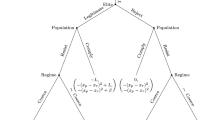Abstract
To understand why political protests show the effects of tipping over into revolution – effects that stun observers, participants, and even the opposition or incumbent government – scholars have constructed threshold models of revolt to illustrate that an important feature of collective rebellion is people deciding to join based on knowing how many others have already participated. I conduct equilibrium analyses to observe the effects of normal, bimodal, and skewed distributions of thresholds upon the dynamics of opposition movements. The results shed some light on how various patterns of domestic confrontation affect the outcome of collective dissent.
Similar content being viewed by others
References
Becker, G. (1968). Crime and punishment: An economic approach. Journal of Political Economy76: 169-217.
Berk, R. (1974). A gaming approach to crowd behavior. American Sociological Review39: 355-373.
Chong, D. (1991). Collective action and the civil rights movement. Chicago: University of Chicago Press.
Collins, R. (1995). Prediction in macrosociology: The case of the Soviet collapse. American Journal of Sociology100: 1552-1593.
DeNardo, J. (1985). Power in numbers. Princeton: Princeton University Press.
Granovetter, M. (1978). Threshold models of collective behavior. American Journal of Sociology83: 1420-1142.
Hardin, R. (1982). Collective action. Baltimore: John Hopkins University Press.
Johnson, N.L. and Kotz, S. (1970). Continuous univariate distributions-1. Boston: Houghton Mifflin.
Kaempfer, W. and Lowenberg, A. (1992). Using threshold models to explain international relations. Public Choice73: 419-444.
Kiser, E. (1995). What can sociological theories predict? Comment on Collins, Kuran, and Tilly. American Journal of Sociology100: 1611-1615.
Kuran, T. (1987). Chamelion voters and public choice. Public Choice53: 53-78.
Kuran, T. (1989). Sparks and prairie fires: Theory of unanticipated revolutions. Public Choice61: 41-74.
Kuran, T. (1991). Now out of never: The element of surprise in the East European revolution of 1989. World Politics44: 7-48.
Kuran, T. (1995a). Private truths, public lies: The social consequences of preference falsification. Cambridge: Harvard University Press.
Kuran, T. (1995b). The inevitability of future revolutionary surprises. American Journal of Sociology100: 1528-1551.
Lichbach, M.I. (1995). The rebel's dilemma. Ann Arbor: University of Michigan Press.
Lohmann, S. (1993). A signaling model of informative and manipulative political action. American Political Science Review87: 319-333.
Lohmann, S. (1994a). Dynamics of information cascades: The Monday demonstrations in Leipzig, East Germany, 1989–1991. World Politics47: 42-101.
Lohmann, S. (1994b). Information aggregation through costly political action. American Economic Review84: 518-530.
Marwell, G. and Oliver, P. (1993). The critical mass in collective action: A micro-social theory. Cambridge: Cambridge University Press.
Rice, J. (1988). Mathematical statistics and data analysis. Pacific Grove, CA: Wadsworth & Brooks.
Schelling, T. (1978). Micromotives and macrobehavior. New York: Norton.
Shi, T. (1990). The democratic movement in China in 1989: Dynamics and failure. Asian Survey30: 1186-1205.
Tilly, C. (1995). To explain political processes. American Journal of Sociology100: 1594-1610.
Tullock, G. (1971). The paradox of revolution. Public Choice11: 89-100.
Yin, C. (1996). Explaining rebellious collective action: Competing theories of grievance and strategy. Ph.D. dissertation, University of California, Los Angeles.
Author information
Authors and Affiliations
Rights and permissions
About this article
Cite this article
Yin, Cc. Equilibria of collective action in different distributions of protest thresholds. Public Choice 97, 535–567 (1998). https://doi.org/10.1023/A:1004921725560
Issue Date:
DOI: https://doi.org/10.1023/A:1004921725560




